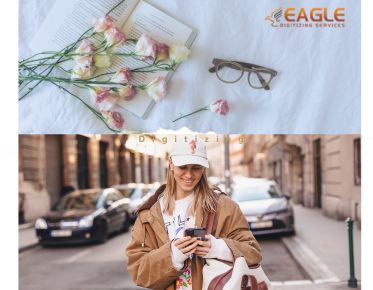Digitized Embroidery 101: The Role of Fabric in Stitch Selection
Digitizedembroidery marries creativity with technology, transforming intricate designs
into stitched masterpieces. This art form relies on both artistic vision and
scientific precision. Each stitch is a calculated move, meticulously planned to
ensure a flawless finish. It’s a delicate balance of aesthetics and
functionality, where the design, technique, and, importantly, the fabric
converge to create a cohesive and visually striking outcome. Understanding the
nuances of fabric selection is crucial for anyone venturing into the world of
digitized embroidery.
Why Fabric Matters in Embroidery
Understanding
the Connection Between Fabric and Stitch Quality
Fabric choice
profoundly impacts stitch quality. The fibers, weave, and weight all contribute
to how well a design translates from a digital file to a physical object.
High-quality fabrics provide a sturdy foundation for embroidery, allowing
stitches to hold their shape and integrity over time. Conversely, subpar
materials can lead to misaligned stitches, puckering, or even fabric damage,
resulting in a disappointing finished product. Thus, understanding how fabric
interacts with various stitch types is essential for achieving professional
results.
How
Fabric Choice Influences Overall Design
The choice of
fabric dictates not just how a design looks but also how it behaves. For
instance, a lightweight fabric may necessitate a different stitch approach
compared to heavier options. Moreover, fabric texture and color can enhance or
detract from the overall design. A vibrant thread on a neutral fabric can
create a stunning contrast, while intricate designs on busy patterns may become
lost. Therefore, careful consideration of fabric selection is key to executing
a successful embroidery project.
Exploring Different Fabric Types
Cotton:
The Classic Choice for Embroidery
Cotton stands as
the quintessential fabric for embroidery, prized for its versatility and ease
of use. This natural fiber is forgiving, allowing stitches to nestle neatly
without slipping or distorting. Its breathability and softness make it ideal
for a variety of projects, from clothing to home decor. Additionally, cotton
readily absorbs dyes, enabling vibrant colors to shine through. When
considering fabric options, cotton remains a reliable choice, especially for
beginners.
Polyester:
Durability Meets Affordability
Polyester, a
synthetic fabric, combines durability with cost-effectiveness. This fabric is
resistant to wrinkling, fading, and shrinking, making it an excellent option
for items that will see regular wear. Polyester's smooth surface also allows
for clean stitching and intricate designs. However, it's crucial to select the
right type of polyester; some variants may not hold embroidery as well as
others. Overall, polyester serves as a practical choice for those seeking both
quality and value.
Specialty
Fabrics: Silk, Velvet, and Beyond
For those looking
to elevate their embroidery projects, specialty fabrics like silk and velvet
provide unique textures and aesthetics. Silk, with its luxurious sheen, demands
careful handling but rewards with stunning results. Velvet offers a plush, rich
appearance but can pose challenges due to its pile. Understanding how these
fabrics interact with different stitching techniques is vital. While they can
create breathtaking designs, working with specialty fabrics requires skill and
precision to avoid mishaps.
Understanding Fabric Weight
What
is Fabric Weight, and Why Is It Important?
Fabric weight
refers to the density of the material, typically measured in grams per square meter
(GSM). Understanding fabric weight is critical as it influences both the type
of stitching and the overall design outcome. Lightweight fabrics are often more
delicate, requiring careful stitch selection to avoid distortion, while heavier
fabrics can support more intricate designs. Knowledge of fabric weight helps
embroiderers make informed decisions about their projects.
Light
vs. Heavy Fabrics: Choosing the Right Stitch
When selecting
stitches for different fabric weights, it's essential to match the stitch type
to the fabric’s characteristics. Light fabrics, such as chiffon or silk,
benefit from finer stitches that won’t overwhelm the material. Conversely,
heavier fabrics, like canvas or denim, can accommodate more robust stitching,
allowing for bolder designs. Making the right choice ensures that the
embroidery not only looks good but also withstands the test of time.
Tips
for Working with Different Fabric Weights
Navigating the
nuances of various fabric weights requires some finesse. For lighter materials,
consider using stabilizers to maintain structure and avoid puckering. Heavier
fabrics might need adjustments to needle size and thread type to accommodate
their density. Always test stitch samples before committing to the final
design. This experimentation allows for adjustments that can make all the
difference in the finished product.
Fabric Texture and Its Impact on Stitch Selection
Smooth
Fabrics: Best Practices for Embroidery
Smooth fabrics,
such as satin or taffeta, are a dream for embroiderers. These materials allow
stitches to glide easily, resulting in clean, defined designs. When working
with smooth fabrics, it’s crucial to ensure proper thread tension and to use
the correct needle size to avoid snagging. The end result can be a beautifully
polished piece that showcases intricate designs flawlessly.
Textured
Fabrics: Overcoming Challenges in Stitching
Textured fabrics,
including corduroy or linen, present unique challenges during the embroidery
process. Their uneven surfaces can lead to uneven stitching if not approached
correctly. To counteract this, using a lower stitch density can help, allowing
the fabric to breathe and reducing the likelihood of puckering. Understanding
how to navigate the intricacies of textured fabrics can elevate your embroidery
game.
Pile
Fabrics: Techniques for Successful Embroidery
Pile fabrics,
such as terry cloth or velvet, offer a unique challenge due to their height and
fluffiness. The key to successful embroidery on these materials is selecting
the right technique. It’s often beneficial to use a cut-away stabilizer to
maintain the design’s integrity and avoid distortion during stitching.
Additionally, using a larger needle can help penetrate the pile without
damaging the fabric. With the right approach, pile fabrics can yield stunning,
tactile results.
The Role of Stretch and Recovery in Fabric
Working
with Stretch Fabrics: Tips for Success
Stretch fabrics,
such as spandex or jersey, require careful handling in embroidery to
accommodate their elasticity. Using the appropriate stabilizer is crucial; a
cut-away stabilizer often works best to maintain the design’s shape during
wear. Additionally, choosing the right needle—preferably a ballpoint—can help
navigate the fabric's stretch without causing damage. When approached
thoughtfully, stretch fabrics can yield vibrant, comfortable pieces.
Non-Stretch
Fabrics: Ensuring Stability in Stitching
Non-stretch
fabrics, like canvas or twill, offer stability, allowing for more robust
stitching techniques. These fabrics tend to hold their shape well during the
embroidery process. However, it’s still essential to maintain proper thread tension
and needle size to ensure the best outcome. The reliability of non-stretch
fabrics makes them a preferred choice for many embroiderers, especially for
projects requiring durability.
The
Importance of Fabric Recovery in Design
Fabric recovery
refers to the material’s ability to return to its original shape after being
stretched. This property is particularly crucial when working with stretch
fabrics. Poor recovery can lead to distorted designs, ruining the overall
aesthetic. Ensuring that the chosen fabric has good recovery capabilities will
help maintain the integrity of the embroidered piece, keeping it looking fresh
and vibrant over time.
Choosing the Right Stitch for Your Fabric
Satin
Stitch: When and How to Use It
The satin stitch
is a staple in embroidery, known for its smooth, lustrous finish. This stitch
is ideal for outlining designs or filling in shapes, particularly on smooth
fabrics. To achieve the best results, ensure that the fabric is taut and that
the thread tension is set correctly. Satin stitches can transform a simple
design into a stunning focal point, adding depth and dimension.
Fill
Stitch: Maximizing Texture on Various Fabrics
Fill stitches are
perfect for creating rich textures and covering larger areas. This technique
works well on both lightweight and heavier fabrics, provided the stitch density
is adjusted accordingly. For lighter fabrics, a lower density prevents
puckering, while heavier fabrics can accommodate more substantial fills.
Understanding how to manipulate fill stitches can significantly enhance the
visual appeal of any embroidered piece.
Running
Stitch: Versatility Across Different Textures
The running
stitch is one of the most versatile techniques in embroidery, suitable for a
wide array of fabric types. It’s perfect for outlining, creating detail, or
even as a decorative element on its own. The simplicity of the running stitch
allows it to shine across various textures, making it a reliable choice for
both beginners and seasoned embroiderers alike.
Common Challenges with Different Fabrics
Thread
Tension Issues: Troubleshooting Tips
Thread tension
can make or break an embroidery project. If stitches appear loose or too tight,
it may indicate an imbalance in tension. Adjusting the tension settings on the
embroidery machine can often resolve these issues. Regularly testing on scrap
fabric can help ensure that the tension is just right before moving on to the
final piece.
Dealing
with Fabric Shrinkage During Stitching
Fabric shrinkage
can be a common concern during the embroidery process, particularly with
natural fibers. To combat this, always pre-wash your fabric and consider using
a stabilizer to maintain structure. If shrinkage occurs, it can distort the
design, leading to disappointing results. Being proactive in your preparation
helps mitigate this challenge.
Managing
Fabric Movement: Techniques to Keep It Steady
Fabric movement
during stitching can lead to inaccuracies and uneven results. To keep fabric
steady, ensure that it is properly hooped and secured. Using stabilizers can
also help anchor the fabric in place. Additionally, adjusting the machine’s
speed can give more control, reducing the likelihood of shifts during the
stitching process.
Testing Stitch Designs on Fabric
The
Importance of Test Stitching Before Full Production
Test stitching is
an invaluable practice in the world of embroidery. Before committing to a full
production run, testing designs on scrap fabric allows for adjustments and
quality control. This step can save time, materials, and frustration, ensuring
that the final product meets expectations.
How
to Analyze Test Results for Quality Control
Once test
stitching is complete, it’s crucial to analyze the results. Check for issues
such as thread tension, fabric puckering, and stitch integrity. Taking note of
any discrepancies allows for fine-tuning before moving on to the final piece.
This attention to detail is what sets successful embroiderers apart.
Making
Adjustments Based on Test Stitching Outcomes
Adjustments based
on test stitching outcomes can be minor yet impactful. Whether it’s altering
thread tension, adjusting stitch density, or selecting a different needle,
small tweaks can lead to significant improvements in the final product. Embracing
a mindset of experimentation and adaptation enhances the overall embroidery
process.
The Impact of Thread Type on Fabric Choice
Understanding
Different Thread Materials: Rayon, Polyester, and More
Thread type plays
a pivotal role in the embroidery process, with various materials offering
distinct advantages. Rayon is known for its sheen and vibrancy, while polyester
offers durability and resistance to fading. Understanding these differences
helps embroiderers select the best thread for their chosen fabric, enhancing
the overall quality of the final product.
How
Thread Thickness Affects Stitch Quality
Thread thickness
significantly influences stitch quality and appearance. Thicker threads can
create bold, eye-catching designs, while thinner threads offer a delicate
touch. The key is to match thread thickness with the fabric type; heavier
fabrics can support thicker threads, while lighter materials may require a more
refined approach. Experimentation with thread thickness can yield stunning
results.
Choosing
the Right Thread Color to Complement Your Fabric
Selecting the
right thread color is essential for enhancing the overall design. Colors that
contrast with the fabric can create striking visuals, while complementary
colors can offer a more subdued elegance. Taking the time to test different
color combinations can lead to truly unique and visually appealing embroidery
projects.
Embroidery is an art form that thrives on creativity and experimentation. Don’t hesitate to try different fabric and stitch combinations. Each project presents an opportunity to discover new techniques and develop a unique style. The more you experiment, the more you’ll learn about the interplay between fabric and stitch selection.


